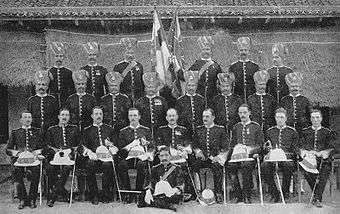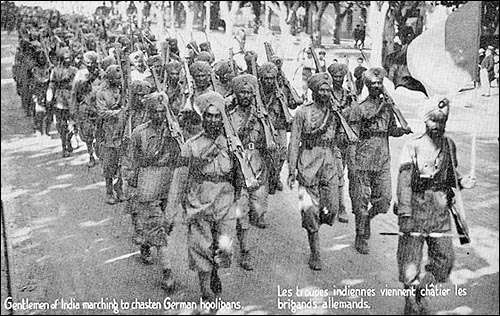Martial race
Martial race was a designation created by army officials of British India after the Indian Rebellion of 1857, where they classified each caste into one of two categories, 'martial' and 'non-martial'. The ostensible reason was that a 'martial race' was typically brave and well-built for fighting,[1] while the 'non-martial races' were those whom the British believed to be unfit for battle because of their sedentary lifestyles. However, an alternative hypothesis is that British-trained Indian soldiers were among those who rebelled in 1857 and thereafter recruitment policy favoured castes which had remained loyal to the British and diminished or abandoned recruitment from the catchment area of the Bengal Army.[2] The concept already had a precedent in Indian culture as one of the four orders (varnas) in the Vedic social system of Hinduism is known as the Kshatriya, literally "warriors".[3] Brahmins were described as 'the oldest martial community',[4] in the past having two of the oldest regiments, the 1st Brahmans and 3rd Brahmans.

Following Indian independence, the Indian government in February 1949 abolished the official application of "martial race" principles with regard to military recruitment.[5]
Criteria
In their attempts to assert control after the Indian Rebellion of 1857, the British faced fierce resistance in some regions while easily conquering others. British officials sought 'martial races' accustomed to hunting, or from agricultural cultures from hilly or mountainous regions with a history of conflict. Others were excluded due to their 'ease of living' or branded as seditious agitators.[6] The doctrine of 'martial races' postulated that the qualities that make a useful soldier are inherited and that most Indians, with the exception of the specified groups, did not have the requisite traits that would make them warriors.[7]
British general and scholar Lieutenant-General Sir George MacMunn (1869–1952) noted in his writings "It is only necessary for a feeling to arise that it is impious and disgraceful to serve the British, for the whole of our fabric to tumble like a house of cards without a shot being fired or a sword unsheathed".[8] To this end, it became British policy to recruit only from those tribes whom they classified as members of the 'martial races', and the practice became an integral part of the recruitment manuals for the Army in the British Raj. According to Jeffrey Greenhut, "The Martial Race theory had an elegant symmetry. Indians who were intelligent and educated were defined as cowards, while those defined as brave were uneducated and backward."[9]
The British regarded the 'martial races' as valiant and strong but also intellectually inferior, lacking the initiative or leadership qualities to command large military formations.[10] They were also regarded as politically subservient or docile to authority.[11] For these reasons, the martial races theory did not lead to officers being recruited from them; recruitment was based on social class and loyalty to the British Raj.[12] One source calls this a "pseudo-ethnological" construction, which was popularised by Frederick Sleigh Roberts, and created serious deficiencies in troop levels during the World Wars, compelling them to recruit from 'non-martial races'.[13] Winston Churchill was reportedly concerned that the theory was abandoned during the war and wrote to the Commander-in-Chief, India that he must, "rely as much as possible on the martial races".[14]
Critics of the theory state that the Indian rebellion of 1857 may have played a role in reinforcing the British belief in it. During this event the troops from the Bengal Native Infantry led by sepoy Mangal Pandey mutinied against the British. However, the loyal Rajputs, Jats, Pashtuns, Punjabis, Gurkhas, Kumaunis and Garhwalis did not join the mutiny, and fought on the side of the British Army. From then on, this theory was used to the hilt to accelerate recruitment from among these 'races', whilst discouraging enlistment of 'disloyal' troops and high-caste Hindus who had sided with the rebel army during the war.[15]
Some authors, such as Heather Streets, argue that the military authorities puffed up the images of the martial soldiers by writing regimental histories, and by extolling the kilted Scots, kukri-wielding Gurkhas and turbaned Sikhs in numerous paintings.[16] Richard Schultz, an American author, has claimed the martial race concept as a supposedly clever British effort to divide and rule the people of India for their own political ends.[17]
Tribes and groups designated as martial races
In British colonial times

_by_AC_Lovett_(1862-1919).jpg)
British-declared martial races in the Indian subcontinent included some groups that were officially designated instead as "agricultural tribes" under the provisions of the Punjab Land Alienation Act of 1900. These terms were considered to be synonymous when the administration compiled a list in 1925. Among the communities listed as martial were:[18]
- Ahir
- Arain
- Awan
- Baloch (Baluch)
- Dogar
- Gakhar
- Gujjars
- Janjua
- Jat
- Kamboh
- Khattar
- Khokhar
- Labana
- Mughal
- Pathan
- Qureshi
- Rajput
- Saini
- Sial
- Syed
- Thakur
Communities that were at various times classified as martial races include:
By the Pakistani military
Though seldom used in today's context, it has been alleged that the Pakistan Military believed in the concept of martial races, and thought that they would easily defeat India in a war, especially prior to the Indo-Pakistani War of 1965.[26][27] Based on this belief in martial supremacy.[28][29][30] and thus numerical superiority of the foe could be overcome.[31]
The Pakistan Army was also accused of bias and racism by the Bengalis of East Pakistan who felt humiliated by this dubious theory that was being floated in West Pakistan, that they were not 'martially inclined' compared to the Punjabis and Pashtuns.[32] Pakistani author Hasan-Askari Rizvi notes that the limited recruitment of Bengali personnel in the Pakistan Army was because the West Pakistanis "could not overcome the hangover of the martial race theory".[33]
Defence writers in Pakistan have noted that the 1971 defeat was partially attributable to the flawed 'martial races' theory which led to wishful thinking that it was possible to defeat the Indian Army based on the theory alone.[34] Author Stephen P. Cohen notes that "Elevating the 'martial races' theory to the level of an absolute truth had domestic implications for Pakistani politics and contributed to the neglect of other aspects of security."[31].
References
- Rand, Gavin (March 2006). "Martial Races and Imperial Subjects: Violence and Governance in Colonial India 1857–1914". European Review of History. Routledge. 13 (1): 1–20. doi:10.1080/13507480600586726.
- Streets, Heather (2004). Martial Races: The military, race and masculinity in British Imperial Culture, 1857–1914. Manchester University Press. ISBN 978-0-7190-6962-8. Retrieved 20 October 2010.
- Das, Santanu (2010). "India, empire and First World War writing". In Boehmer, Elleke; Chaudhuri, Rosinka (eds.). The Indian Postcolonial: A Critical Reader. Routledge. p. 301. ISBN 978-1-13681-957-5.
- Singh, Gajendra (16 January 2014). The Testimonies of Indian Soldiers and the Two World Wars: Between Self and Sepoy. A&C Black. ISBN 978-1-78093-820-2.
- "No More Class Composition in Indian Army" (PDF). Press Information Bureau of India - Archive. 1 February 1949. Retrieved 16 February 2020.
- Ethnic Group Recruitment in the Indian Army; by Dr. Omar Khalidi. Archived 20 October 2006 at the Wayback Machine
- Greenhut, Jeffrey (1984) Sahib and Sepoy: an Inquiry into the Relationship between the British Officers and Native Soldiers of the British Indian Army. (In: Military Affairs, Vol. 48, No. 1 (Jan. 1984), p. 15.
- MacMunn, G. F. (1911). The Armies of India; painted by Major A. C. Lovett. London: Adam & Charles Black.
- Greenhut, Jeffrey (1983) The Imperial Reserve: the Indian Corps on the Western Front, 1914–15. In: The Journal of Imperial and Commonwealth History, October 1983.
- Levine, Philippa ( -?- ) Prostitution, Race and Politics: Policing Venereal Disease in the British Empire; p. 284.
- "Ethnic Group Recruitment in the Indian Army: The Contrasting Cases of Sikhs, Muslims, Gurkhas and Others by Omar Khalidi". Archived from the original on 20 April 2012. Retrieved 4 September 2017.
- Ethnic group recruitment in the Indian army: The contrasting cases of Sikhs, Muslims, Gurkhas and others by Omar Khalidi.
- Country Data – Based on the Country Studies Series by Federal Research Division of the Library of Congress.
- Bose, Mihir. The Magic of Indian Cricket: Cricket and Society in India; p. 25.
- Country Studies: Pakistan – Library of Congress.
- Book review of Martial Races: The military, race and masculinity in British Imperial Culture, 1857–1914 By Heather Streets in The Telegraph.
- Shultz, Richard; Dew, Andrea ( -?- ). Insurgents, Terrorists, and Militias: The Warriors of Contemporary Combat; p. 47).
- Mazumder, Rajit K. (2003). The Indian Army and the Making of Punjab. Orient Longman. p. 105. ISBN 9788178240596.
- Surridge, Keith (2007). "Martial Races: the Military, Race and Masculinity in British Imperial Culture, 1857–1914 (review)". Journal of Victorian Culture. Edinburgh: Edinburgh University Press. 12 (1): 146–150. doi:10.1353/jvc.2007.0017. ISSN 1355-5502.
- gokhale, namita (1998). mountain echoes a reminiscense of kumaoni women. Roli pvt ltd. ISBN 9788174360403.
- Mazumder, Rajit K. (2003). The Indian Army and the Making of Punjab. Orient Longman. p. 99. ISBN 9788178240596.
- Creative Pasts: Historical Memory And Identity in Western India, 1700-1960 From book: "In the early twentieth century, the Marathas were identified as a "martial race" fit for the imperial army, and recruitment of Marathas increased after World War I."
- Hartmann, Paul; Patil, B. R.; Dighe, Anita (1989). The Mass Media and Village Life: An Indian Study. Sage Publications. p. 224. ISBN 0-8039-9581-4.
- Singh, Khushwant (2003). The End of India. Penguin. p. 98. ISBN 978-0143029946.
Punjabi Mussalmans and Khalsa Sikhs were declared 'martial races' for recruitment to the army or the police; only one small Hindu caste, the Mohyal Brahmins, qualified as martial.
- Benjamin B. Cohen (2002). Hindu rulers in a Muslim state L: Hyderabad, 1850–1949. University of Wisconsin–Madison. p. 78.
- Insurgents, Terrorists, and Militias: The Warriors of Contemporary Combat Richard H. Shultz, Andrea Dew: "The Martial Races Theory had firm adherents in Pakistan and this factor played a major role in the under-estimation of the Indian Army by Pakistani soldiers as well as civilian decision makers in 1965."
- United States Library of Congress Country Studies "Most Pakistanis, schooled in the belief of their own martial prowess, refused to accept the possibility of their country's military defeat by 'Hindu India'."
- Indo-Pakistan War of 1965.
- "End-game?" By Ardeshir Cowasjee – 18 July 1999, Dawn.
- India by Stanley Wolpert. Published: University of California Press, 1990. "India's army... quickly dispelled the popular Pakistani myth that one Muslim soldier was 'worth ten Hindus.'"
- The Idea of Pakistan By Stephen P. Cohen Published by Brookings Institution Press, 2004 ISBN 0-8157-1502-1 pp. 103–104.
- Library of Congress studies.
- Rizvi, Hasan-Askari. Military, State and Society in Pakistan. Palgrave Macmillan. p. 128. ISBN 0-312-23193-8.
- Pakistan's Defence Journal.
Further reading
- Cohen, Stephen P. (May 1969). "The Untouchable Soldier: Caste, Politics, and the Indian Army". The Journal of Asian Studies. 28 (3): 453–468. doi:10.1017/s0021911800092779. JSTOR 2943173. (subscription required)
- Cohen, Stephen P. (1971). The Indian Army. Berkeley: University of California Press.
- Chowdhry, Prem (May 2013). "Militarized Masculinities: Shaped and Reshaped in Colonial South-East Punjab". Modern Asian Studies. 47 (3): 713–750. JSTOR 24494165.